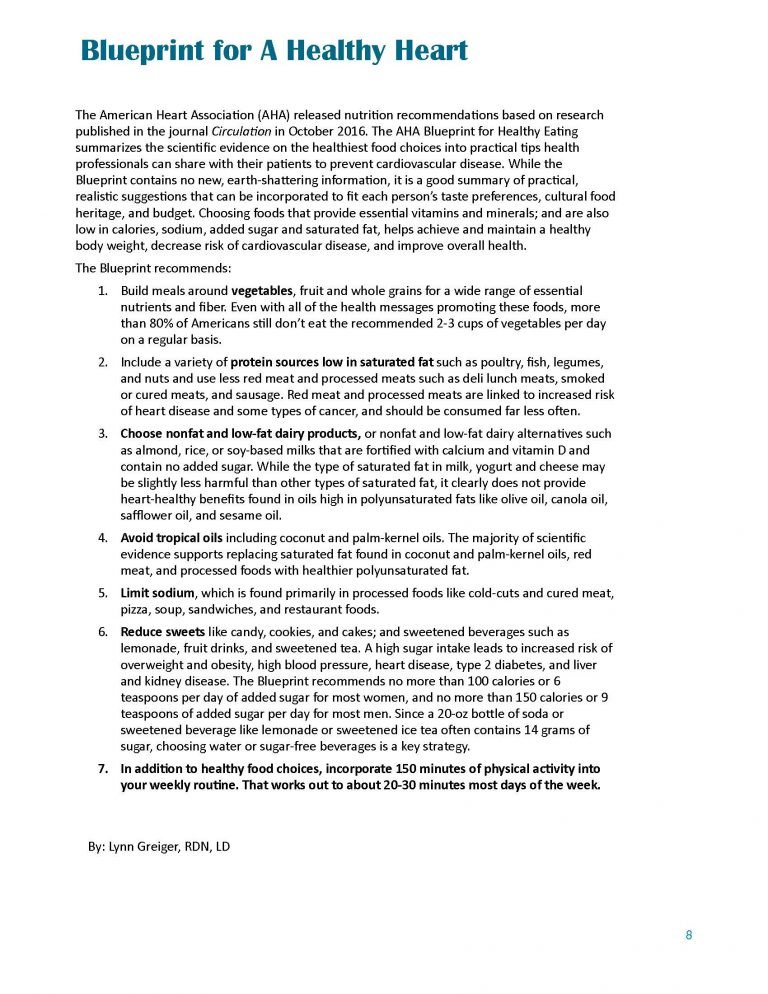American Heart Association Blueprint for Healthy Eating
The American Heart Association (AHA) released nutrition recommendations based on research published in the journal Circulation. The AHA Blueprint for Healthy Eating summarizes the scientific evidence on the healthiest food choices into practical tips health professionals can share with their patients to prevent cardiovascular disease. While the Blueprint contains no new, earth-shattering information, it is a good summary of practical, realistic suggestions that can be incorporated to fit each person’s taste preferences, cultural food heritage, and budget. Choosing foods that provide essential vitamins and minerals; and are also low in calories, sodium, added sugar and saturated fat, helps achieve and maintain a healthy body weight, decrease risk of cardiovascular disease, and improve overall health.The Blueprint recommends:1. Build meals around vegetables, fruit and whole grains for a wide range of essential nutrients and fiber. Even with all of the health messages promoting these foods, more than 80% of Americans still don’t eat the recommended 2-3 cups of vegetables per day on a regular basis.2. Include a variety of protein sources low in saturated fat such as poultry, fish, legumes, and nuts and use less red meat and processed meats such as deli lunch meats, smoked or cured meats, and sausage. Red meat and processed meats are linked to increased risk of heart disease and some types of cancer, and should be consumed far less often.3. Choose nonfat and low-fat dairy products, or nonfat and low-fat dairy alternatives such as almond, rice, or soy-based milks that are fortified with calcium and vitamin D and contain no added sugar. While the type of saturated fat in milk, yogurt and cheese may be slightly less harmful than other types of saturated fat, it clearly does not provide heart-healthy benefits found in oils high in polyunsaturated fats like olive oil, canola oil, safflower oil, and sesame oil.4. Avoid tropical oils including coconut and palm-kernel oils. The majority of scientific evidence supports replacing saturated fat found in coconut and palm-kernel oils, red meat, and processed foods with healthier polyunsaturated fat.5. Limit sodium, which is found primarily in processed foods like cold-cuts and cured meat, pizza, soup, sandwiches, and restaurant foods.6. Reduce sweets like candy, cookies, and cakes; and sweetened beverages such as lemonade, fruit drinks, and sweetened tea. A high sugar intake leads to increased risk of overweight and obesity, high blood pressure, heart disease, type 2 diabetes, and liver and kidney disease. The Blueprint recommends no more than 100 calories or 6 teaspoons per day of added sugar for most women, and no more than 150 calories or 9 teaspoons of added sugar per day for most men. Since a 20-oz bottle of soda or sweetened beverage like lemonade or sweetened ice tea often contains 14 grams of sugar, choosing water or sugar-free beverages is a key strategy.7. In addition to healthy food choices, incorporate 150 minutes of physical activity into your weekly routine. That works out to about 20-30 minutes most days of the week.Use these 4 tips to enjoy delicious meals that meet the Blueprint recommendations:1. Enjoy vegetables including broccoli, carrots, collards, green beans, green peas, kale, lima beans, sweet potatoes, spinach, squash, tomatoes, and peppers as part of meals and snacks. Choose fresh or frozen vegetables, and serve them raw or cooked. Try this: Add dark green leafies like spinach, kale or collards to eggs for breakfast, use raw celery or green pepper with hummus for a snack, and offer both a fresh salad and a cooked vegetable with dinner.2. Include fruit such as apricots, bananas, dates, grapes, oranges, orange juice, grapefruit, grapefruit juice, mangoes, melons, papaya, peaches, pears, pineapples, raisins, raspberries, strawberries, and tangerines for snacks and meals. Choose fresh fruit, or fruit frozen or canned without added sugar. Try this: Slice fresh fruit on your morning bowl of cereal, blend frozen fruit into plain yogurt for a smoothie, keep a bowl of fresh fruit on the kitchen counter for easy snacking, and end meals with fruit instead of a sweet dessert.3. Choose whole grains including whole-wheat bread and rolls, whole-wheat pasta, cereals such as grits or oatmeal; brown rice, and popcorn instead of highly processed foods made from white flour for more fiber and nutrients. Look for the word ‘whole’ in the first ingredient to be sure you’re purchasing 100% whole grain foods. Try this: Enjoy a whole grain breakfast cereal like Shredded Wheat, Cheerios or unflavored oatmeal; make sandwiches with whole grain bread, and serve brown rice or other whole grains like quinoa or amaranth with dinner.4. Limit added sugar by replacing foods with added sugar like cookies, cakes and candy with nutrient-dense, healthier foods including fresh fruit, unsalted nuts, or popcorn with a sprinkle of cheese, chili powder, or cinnamon for flavor. Try this: Cook unflavored oatmeal with frozen fruit and top with cinnamon instead of using flavored oatmeal, snack on fresh fruit or dried fruit without added sugar, freeze gapes for a healthy pop of sweetness.References:American Heart Association. A Blueprint for Healthy Eating. https://sodiumbreakup.heart.org/a_blueprint_for_healthy_eating Published 10-31-16; Accessed 1-10-17.Recommended Dietary Pattern to Achieve Adherence to the American Heart Association/AmericanCollege of Cardiology (AHA/ACC) Guidelines: A Scientific Statement From the American Heart Association. Van Horn, L et al. Circulation. 2016 Nov 29;134(22):e505-e529.By Lynn Greiger, RDN, LDDownload article handoutDownload infographic handout
 SaveSaveSaveSave
SaveSaveSaveSave